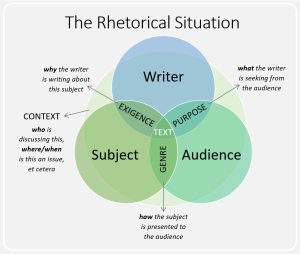1 How to Sing a Narrative:
Devin Nardecchia
Narrative essays come in a multitude of forms but are usually broken down into two styles: the Personal Narrative and the Literacy Narrative. A personal narrative is one told by an individual and uses experiences from their own lives, while a literacy narrative uses a piece (or pieces) of literature to do the same. In this section of the textbook, we will focus on how to use your own personal experiences and stories to convey a message through your prose.
Personal Narrative + Rhetorical Strategies
It is good to have a decent understanding of the topic you will be writing on, but it is arguably more important to know the specific message that you are trying to pass onto the reader and the intentional techniques for doing just that. One deliberate strategy is through rhetoric. Writers must have an understanding of rhetoric. According to Aristotle, rhetoric has three parts: first is the systemic study of the speaker, next is the study of the message, and finally is the study of the audience. When you write or tell a story, you should always keep these three elements in mind.
Aristotle taught his academic disciples that in order for a speaker to convince the audience of their message, one must employ multiple strategies. The three main strategies are ethos, logos, and pathos.
Ethos is described as one’s credibility and trust. In other words, why should the reader trust you or the sources that you use? What makes you or the sources that you use believable and an authority on the topic?
Logos is the use of logic and reasoning. What statistics can you show to the reader that may change their mind? How can you structure your speech to be more digestible? What comparisons or metaphors can be used to better explain the points you are making? How can you articulate what you are saying in a way that your reader can comprehend?
Pathos focuses on emotion and morals. What relatable imagery can you invoke? Do you have an example of a struggle story? What biases do you have or might the reader have?
As a bonus, there is a fourth rhetorical strategy: Kairos is the skill of adapting your persuasion strategy to the situation and the use of proper timing. How do your decisions or experiences align with trends (past or present)? How do you use timing in a calculated way for others to best receive your message?
No two people are the same, and your rhetorical choices should reflect this fact. Use multiple strategies in each of your papers to ensure that you are conveying your message as effectively as you can to as many people as possible.
It’s easy to forget that while you know all the details of your story, your reader may not have any idea what you are talking about. Thus it is important to include as much information as possible in the most direct way possible. Be careful not to get lost in the weeds because you may lose the reader in the unnecessary details that are weighing down your paper.
Literacy Narrative
A Literacy Narrative is a story of how you became literate, how your literacy evolved, and how it has affected your life. Literacy Narratives necessitate the use of description. The topics are centered around the evolution of your speech, writing, and reading. This may be a harder essay to write due to the need to stick to the “literacy” part of the work. Of course, you could view literacy in the narrow view of reading and writing. However, if we broaden the meaning of literacy to include all forms of communication and other mediums besides books, then we may find a more tenable way to write our literacy journey.

For instance, many of us are familiar with works from J.R.R. Tolkien such as The Hobbit. Tolkien uses a lot of descriptor words throughout the story, spending pages poring over how Tolkien describes the taste and smells of Middle-Earth almost to a point where it could slow the pacing of the story to a near halt. Someone who was influenced by his work may feel a need to over-describe details of a story that they are telling friends or family. While this may not work for casual conversation, these detailed retellings would align perfectly with retelling one’s own narrative.
On the other hand, someone who grew up in the “meme age of the internet” may find that they best communicate their thoughts and ideas with a single image with as minimal text as possible, or may use the shared collective knowledge of pop culture to use references that most would be able to understand. These writers may need to rely on adding additional sensory elements to their writing to make their ideas more evocative. Adding in taste, smell, feel, touch, hearing, and even temperature can make a piece of writing come alive.
A third example could be a story of how an immigrant learned a second or third language in order to communicate with those around them describing the difficulties of learning the nuances of their second language and the slang attached to speaking in a second tongue.
Citations
Personal Narrative citation:
College Essay Writing: Personal Narrative, Ilinois Wesleyan WC/TS
Rhetoric:
https://www.owl.purdue.edu/owl/general_writing/academic_writing/rhetorical_situation/aristotles_rhetorical_situation.html
Literacy citation:
https://writingcraft.commons.gc.cuny.edu/literacy-essay-examples/

